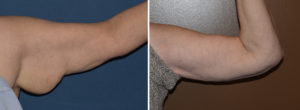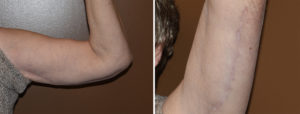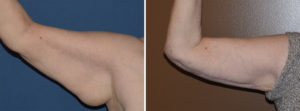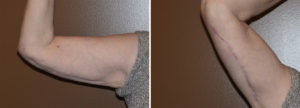Background: Large amounts of weight loss is a very positive benefit to one’s health when needed. But the tradeoff for this medical and often needed benefit is the unaesthetic sequelae of loose skin. How significant this new problem is depends on many factors including the amount of weight loss, patient’s age, natural quality of their skin, gender and the specific body area.
One body area that is hit particularly hard when large amounts of weight loss has occurred is the arms. This is particularly true in women. Stretched out skin and fat fall off of the back the arms and hangs. Often referred to as ‘batwings’, these unflattering segments of loose skin also pose problems for clothing wear in addition to their embarrassing appearance.
Arm lift surgery for ‘bat wings’ has been around for decades and is not new. It has been used for body contouring long before bariatric surgery and other forms of weight loss ha come into widespread use. While contemporary arm lift surgery has undergo some advancements (concomitant use of liposuction, incisional placements and the development smaller versions of it), its fundamental premise is the same. One has to be willing to tradeoff a long scar for a complete upper arm reduction/reshaping.
Case Study: This 65 year-old female has lost some weight but her arms never really changed that much. Rather than having a batwing deformity that involved the whole upper arm, her worst tissue sag was in the upper half of the arm closer to the armpit.



Highlights:
1) The posterior or medial arm lift is the only reshaping procedure of the upper arm when skin removal is needed.
2) Arm lifts are very successful procedures that do definitely solve the sagging upper arm problem.
3) All maximally effective arm lifts involve a longitudinal scar that runs between the armpit and the elbow whose aesthetic appearance is often not ideal.
Dr. Barry Eppley
Indianapolis, Indiana




